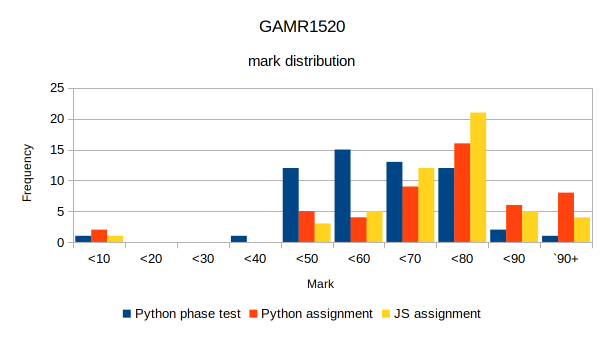Python and Javascript
In this module we will learn the basics of two dynamically typed languages.

 and
Javascript
and
Javascript
Assessment
The module will be assessed in three parts.
-
A python phase test (20%)
- In the third week of the module (12th December).
- Covering the basics we will learn in the next two weeks
- Automatically marked within blackboard
-
A python coding assignment (40%)
- Deadline January 17th
- You will be provided with automated unit tests
- 80% of the marks will be awarded for passing the tests
- 20% of the marks for style/efficiency
-
A Javascript coding assignment (40%)
- Deadline January 24th.
- A more creative coding challenge
- Create an animated HTML canvas
- Marked on functionality and code quality/readability
Schedule

Previous results


A simple model of computation
A basic model of a computer has memory which holds data and a CPU which manages instructions and performs calculations.

Modern computers are said to be computationally universal because they can be programmed to do any computation.
Instruction set
Every processor has an instruction set which defines the primitive operations that it can perform. These are the building blocks from which all computer programmes are constructed.
- data handling and memory
- arithmetic and logic operations
- control flow

Such instructions are provided to the processor in machine code, the lowest-level of computer ‘language’, in which each instruction is represented by a unique combination of bits.
Compilation
Some computer languages (such as C and Rust) are compiled into a format suitable for the CPU to consume directly.
This compilation step can produce very efficient code through careful analysis and optimisation. However, it needs to be performed specifically for a given hardware architecture and typically requires the programmer to manage all the details of memory management.
Compilers are bootstrapped in another language and then self-compiled. Assembly languages are said to be assembled rather than compiled. Each assembly language is typically restricted to one processor architecture.
Interpretation
Other languages (such as python and javascript) are compiled to an intermediate form that is interpreted by a special programme that actually interacts with the processor.
Interpreted languages define their own byte code specifications which can be used on any machine.
This makes them portable and very convenient.
The canonical Python compiler/interpreter implementation is CPython (written in C). Though there are many different implementations (e.g. IronPython, Jython, PyPy)
Memory and data types
Binary data in memory can store integers.
Complex data can be represented in binary format through standards such as ASCII and unicode for characters and IEEE754 for floating point numbers (i.e. non-integers).
This is what we mean by the type of data. All data in computers is ultimately stored as zeroes and ones but what those zeroes and ones means depends on what you are doing.
Pointers
An important type of data is pointer which holds the value of a unique memory address. Pointers identify the location of some other data in memory. Every location in memory has a unique address.
32-bits of data are enough to uniquely identify a single byte within 232 bytes (4,294,967,296 bytes or 4 GB) of memory.
64-bits of data are in principle enough to uniquely identify a single byte within 264 bytes (18,446,744,073,709,551,616 bytes or 16 Billion GB) of memory. Though a real system doesn’t quite use 64 bits for directly addressing memory.
Statically typed variables
In languages with statically typed variables, each variable must be declared with a type that cannot change.
This code in C demonstrates the idea.
We are declaring a variable a of type int and assigning it to the value 1.
Then the code updates the value of a, setting it to 2.
int a = 1;
a = 2;
Both operations will write data into the same chunk of memory.
Since C is a statically typed language, the type of a variable cannot be changed.
int b = 1;
b = "two";
This code will not compile.
Python as a dynamically typed language
TLDR; In dynamically typed languages type information is associated with the data, not the variable.
Python has dynamically-typed variables. In practice, this means that variables can be changed fom one type to another.
a = 1
a = 'two'
a = true
a = 2.2
a = [1, 2, 3]
a = {"this is": "a dictionary"}
There is a lot going on under the hood with python, even with this simple programme. By relinquishing some control to python, your code can be simple and expressive.
Dynamically typed languages
In dynamically typed languages, types are associated with values, not variables.
All data in python are represented internally as pyObjects.
The following code creates a pyObject of type <int> with the value 1.
a = 1
In python, variables are simply names, pointing to these complex objects.
| pyObject | |
|---|---|
| id | 0x7fa8655e00f0 |
| type | <class 'int'> |
| value | 1 |
| refs | 1 |
Each pyObject has an integer id, a pointer to a type, a value, which can be a pointer (for compound types) and a reference count integer.
Inspecting a pyObject’s identifier
We can view the identifier of an object in python using built-in function id().
id(a)
140361231892720
The identifier is an integer.
We can express it as a hexadecimal using an f-string.
f'{id(a):#x}'0x7fa8655e00f0In the CPython implementation, the id is a memory location.
Inspecting object type
The built-in function type will allow us to inspect the type of a.
type(a)
<class 'int'>
The type in this case, is the class int.
Integers are instances of the class int
Types also have a type!
type(type(a))<class 'type'>Types are instances of the class
type!
Memory usage
We can inspect the size of a variable in memory using the getsizeof function from the sys module in the python standard library.
from sys import getsizeof
getsizeof(1) # 28
getsizeof(type(1)) # 416
The size of the integer
1in memory is 28 bytes. The size of the type<class 'int'>is 416 bytes. Both are pyObjects.
We can see that larger integers take a bit more room.
for i in range(20):
print(10**i, getsizeof(10**i))
Inspecting attributes
Depending on their type, objects sometimes have methods which we can use.
To get a list of all attributes, we can use the built-in dir() function.
The result can be confusing.
String objects have lots of methods.
Many of which are so-called __dunder__ methods.
dir('hello')
['__add__', '__class__', '__contains__', '__delattr__', '__dir__', '__doc__', '__eq__', '__format__', '__ge__', '__getattribute__', '__getitem__', '__getnewargs__', '__getstate__', '__gt__', '__hash__', '__init__', '__init_subclass__', '__iter__', '__le__', '__len__', '__lt__', '__mod__', '__mul__', '__ne__', '__new__', '__reduce__', '__reduce_ex__', '__repr__', '__rmod__', '__rmul__', '__setattr__', '__sizeof__', '__str__', '__subclasshook__', 'capitalize', 'casefold', 'center', 'count', 'encode', 'endswith', 'expandtabs', 'find', 'format', 'format_map', 'index', 'isalnum', 'isalpha', 'isascii', 'isdecimal', 'isdigit', 'isidentifier', 'islower', 'isnumeric', 'isprintable', 'isspace', 'istitle', 'isupper', 'join', 'ljust', 'lower', 'lstrip', 'maketrans', 'partition', 'removeprefix', 'removesuffix', 'replace', 'rfind', 'rindex', 'rjust', 'rpartition', 'rsplit', 'rstrip', 'split', 'splitlines', 'startswith', 'strip', 'swapcase', 'title', 'translate', 'upper', 'zfill']
Ignore the __dunder__ methods
In python, methods (and other attributes) with double underscores are special. For now, we can ignore them with a list comprehension that filters the list to only those without the double underscores.
[method for method in dir('hello') if not method.startswith('__')]
['capitalize', 'casefold', 'center', 'count', 'encode', 'endswith', 'expandtabs', 'find', 'format', 'format_map', 'index', 'isalnum', 'isalpha', 'isascii', 'isdecimal', 'isdigit', 'isidentifier', 'islower', 'isnumeric', 'isprintable', 'isspace', 'istitle', 'isupper', 'join', 'ljust', 'lower', 'lstrip', 'maketrans', 'partition', 'removeprefix', 'removesuffix', 'replace', 'rfind', 'rindex', 'rjust', 'rpartition', 'rsplit', 'rstrip', 'split', 'splitlines', 'startswith', 'strip', 'swapcase', 'title', 'translate', 'upper', 'zfill']
Notice that the dir method returned a list of string attribute names.
Also notice that we used the startswith method in the above list comprehension.
Python origins
Python was created in 1990 by Guido van Rossum with emphasis on code readability, its syntax allows programmers to express concepts in fewer lines of code.


Readability counts “A programming language is more than how you tell a computer what to do. It is how programmers express and communicate ideas. The audience for your code is other programmers, not computers.” Guido van Rossum
Development
The first official release was in 1991. By 2001, ten years later, the Python Software Foundation was launched.
Python has evolved over decades and been through some major changes in that time. In particular, the traumatic transition to python3.
Python comes with batteries included

Open source tools
The Zen of Python (1999)
import this
The Zen of Python, by Tim Peters
Beautiful is better than ugly.
Explicit is better than implicit.
Simple is better than complex.
Complex is better than complicated.
Flat is better than nested.
Sparse is better than dense.
Readability counts.
Special cases aren't special enough to break the rules.
Although practicality beats purity.
Errors should never pass silently.
Unless explicitly silenced.
In the face of ambiguity, refuse the temptation to guess.
There should be one-- and preferably only one --obvious way to do it.
Although that way may not be obvious at first unless you're Dutch.
Now is better than never.
Although never is often better than *right* now.
If the implementation is hard to explain, it's a bad idea.
If the implementation is easy to explain, it may be a good idea.
Namespaces are one honking great idea -- let's do more of those!

